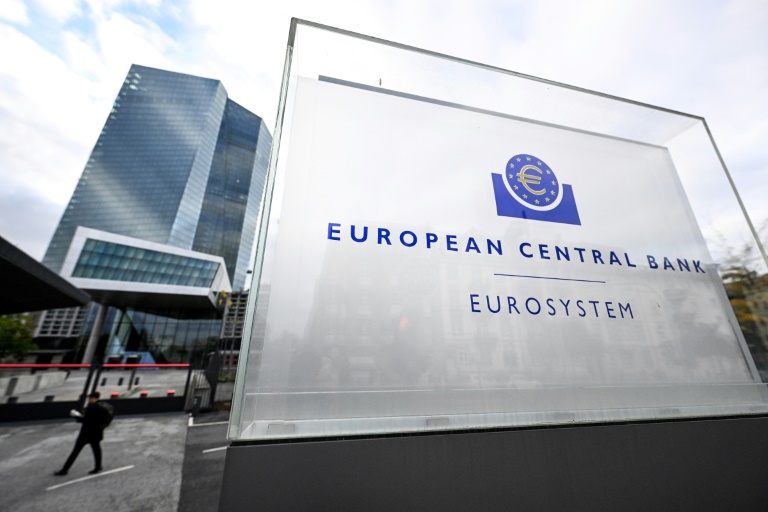BoE pauses, ECB tipped to follow as rate cut pressure mounts

The ECB’s newest economic forecasts on Thursday could be key to charting a course forward – Copyright AFP/File Stefani Reynolds
Michelle FITZPATRICK with AFP bureaus
The Bank of England held rates steady again Thursday with the European Central Bank expected to follow suit as inflation retreats, shifting investor attention to how fast policymakers will slash borrowing costs in 2024.
BoE policymakers opted for a third consecutive pause in their final meeting of 2023, leaving the main interest rate at a 15-year high of 5.25 percent.
The rate would remain high “for an extended period”, the BoE warned.
UK inflation slowed sharply to 4.6 percent in October but remains well above the two-percent target.
In Frankfurt, the ECB was widely expected to leave rates unchanged for a second straight time, following a historic streak of hikes to tame runaway prices.
A pause would keep the ECB’s benchmark deposit rate at a record high of four percent.
With inflation dropping faster than expected in many countries and the economic outlook darkening, investors are increasingly betting that policymakers will start cutting rates earlier than previously thought.
The US Federal Reserve set the tone on Wednesday, leaving its rates at a 22-year high and indicating that it expected three rate cuts in 2024.
Markets cheered the much-sought-after dovish pivot, triggering a global rally that saw Wall Street soar to record highs.
Despite the upbeat mood, analysts said they expected European decision-makers to push back against investor hopes of a rapid pace of rate cuts next year as inflation worries persist.
ECB president Christine Lagarde was expected to use her afternoon press conference to signal that it was too soon to declare victory, analysts said.
“Markets will probably have to correct some of their over-optimistic rate cut expectations once the ECB has spoken,” said Berenberg bank economist Holger Schmieding.
– Swiss pause, Norwegian hike –
On a bumper day of central bank action on Thursday, the Swiss National Bank announced it was holding its key interest rate at 1.75 percent as it revised its inflation forecasts downward.
Norway’s Norges Bank meanwhile bucked the pausing trend by raising its main interest rate by a quarter percentage point to 4.5 percent. It signalled, however, that the hike was likely the final one in the current cycle.
Back in the eurozone, many analysts have long said they think the ECB will start slashing rates in June.
But a recent fall in eurozone inflation has prompted some to predict a first reduction as early as March or April.
Inflation in the 20-nation currency club tumbled to 2.4 percent in November, a two-year low and not far off the ECB’s two-percent target.
Inflation had peaked at about 10 percent last year after prices were pushed up first by post-pandemic supply chain woes, and then an energy crisis triggered by Russia’s invasion of Ukraine.
A weakening economy has provided further ammunition for those arguing for a cut sooner rather than later.
The European Commission last month lowered its growth forecasts for 2023 and 2024 and the ECB itself has warned that a recession was a “possible scenario”.
But uncertainty remains about the path forward, with ECB officials expressing concern that rising wages in the euro area could drive inflation higher again. An escalation of the Hamas-Israel war could also push up energy prices.
Lagarde has repeatedly stressed that the ECB’s next moves will be “data dependent”.
The bank’s newest economic forecasts on Thursday could be key to charting a course forward.
Analysts expect both the inflation and growth outlook to be trimmed. The forecasts will also for the first time include the year 2026.
“The lower the ECB’s growth and inflation forecasts for 2024 and 2025, the higher the likelihood of rate cuts,” said ING economist Carsten Brzeski.
BoE pauses, ECB tipped to follow as rate cut pressure mounts
#BoE #pauses #ECB #tipped #follow #rate #cut #pressure #mounts





